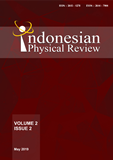IDENTIFICATION OF BURIED ARCHEOLOGICAL OBJECTS WITH RADIAL DERIVATIVES OF MICRO GRAVITY DATA
DOI:
10.29303/ipr.v2i2.25Downloads
Abstract
The development of recent gravimetric technology allows us to measure gravity anomalies with accuracy of micro Gal. Micro gravity is able to detect very small gravity anomalies such as anomaly due to buried archeological objects below the earth surface. Radial Derivatives of gravity data is used to sharpen anomaly due to lateral changes of density contrast. Horizontal derivatives carried out by previous researchers have some weaknesses, i.e. the loss of derivative values in certain directions and inconsistence values at the source boundary of the same anomaly edge. To solve the horizontal derivative problem, a radial derivative is made. Radial derivative is derivative of gravity anomaly over horizontal distance in the radial direction from a certain point which is considered as the center of anomaly. There are two kind of radial derivative i.e. First Radial Derivative (FRD) and Second Radial Derivative (SRD). Blade Pattern is another way to enrich the ability of SRD to detect boundary of anomaly source. Synthetic gravity data of buried archeological object was made by counting the response of forward modelling. All of programs and calculation of the models in this research is performed based on Matlab® program. The results of the tests on the synthetic data of the model show that the radial derivative is able to detect the boundaries in buried temples due to density contrast. The advantage of radial derivatives which is a horizontal derivative in the direction of radial compared to ordinary horizontal derivatives is the ability to detect vertical boundaries of various anomaly due to horizontal layers and capable of showing density contrast in almost all directions.References
Tsuboi and Kato (1952). The First and Second Vertical Derivative of Gravity, Journal of Physics of The Earth. Vol 1, no 2.
Rao, B.S.R., Murthy, I.V.R., and Rao, Y.S.F.,1971, A Second Derivative Method of Interpretation of Gravity Anomalies of Anticlines,Geophysics Department, Andhra University, Waltair, India.
Abdelrahman, E. M., El-Araby, H. M., El-Araby, T. M., and Abbo-Ezz, E. R., 2003, A least-squares derivatives analysis of gravity anomalies due to faulted thin slabs, Geophysics, Vol. 68, No. 2 (March-April 2003); P. 535–543, 11 Figs., 3 Tables.10.1190/1.1567222
Oruc, B., 2010, Edge Detection and Depth Estimation Using a Tilt Angle Map from Gravity Gradient Data of the Kozaklı-Central Anatolia Region, Turkey, Pure Appl. Geophys. 2010 Springer Basel AG DOI 10.1007/s00024-010-0211-0
Aydogan, D., 2011, Extraction of lineaments from gravity anomali maps using the gradient calculation: Application to Central Anatolia, Earth Planets Space, 63, 903–913, 2011
Tatchum, C.N., Tabod, T. C., Koumetio, F., and Manguelle-Dicoum, E., 2011, A Gravity Model Study for Differentiating Vertical and Dipping Geological Contacts with Application to a Bouguer Gravity Anomali Over the Foumban Shear Zone, Cameroon, Geophysica (2011), 47(1–2), 43–55.
Aku, M. O., 2014, Application Of Second Vertical Derivative Analytical Method To Bouguer Data For The Purpose Of Delineation Of Lithological Boundaries, Science World Journal Vol 9 (No 3) 2014
Askari, A., 2014, Edge detection of gravity anomali sources via the tilt angle, total horizontal derivative, total horizontal derivative of the tilt angle and new normalized total horizontal derivative, Scholars Journal of Engineering and Technology (SJET) ISSN 2321-435X (Online) Sch. J. Eng. Tech., 2014; 2(6B):842-846 ISSN 2347-9523 (Print)
Wahyudi. E. J., Kynantoro, Y., and Alawiyah, S., 2016, Second Vertical Derivative Using 3-D Gravity Data for Fault Structure Interpretation, International Conference on Energy Sciences (ICES 2016) IOP Publishing IOP Conf. Series: Journal of Physics: Conf. Series 877 (2017) 012039 doi :10.1088/1742-6596/877/1/012039.
Muhammad Zuhdi, Sismanto, Ari Setiawan, Jarot Setyowiyoto, Adi Susilo, Muhammad Sarkowi, Radial Derivative And Radial Inversion For Interpreting 4D Gravity Anomaly Due To Fluids Injection Around Reservoir. Telkomnika, Vol.16, No.6, December 2018, pp.2855~2863
Kadir, W. G. A., 1999, “Survey Gravitasi 4D dan dinamika Sumber Bawah Permukaanâ€: Proceeding Himpunan Ahli Geofisika Indonesia, 94-99.
License
Authors who publish with Indonesian Physical Review Journal, agree to the following terms:
- Authors retain copyright and grant the journal right of first publication with the work simultaneously licensed under a Creative Commons Attribution-ShareAlike 4.0 International Licence (CC BY SA-4.0). This license allows authors to use all articles, data sets, graphics, and appendices in data mining applications, search engines, web sites, blogs, and other platforms by providing an appropriate reference. The journal allows the author(s) to hold the copyright without restrictions and will retain publishing rights without restrictions.
- Authors are able to enter into separate, additional contractual arrangements for the non-exclusive distribution of the journal's published version of the work (e.g., post it to an institutional repository or publish it in a book), with an acknowledgment of its initial publication in Indonesian Physical Review Journal.
- Authors are permitted and encouraged to post their work online (e.g., in institutional repositories or on their website) prior to and during the submission process, as it can lead to productive exchanges, as well as earlier and greater citation of published work (See The Effect of Open Access).





